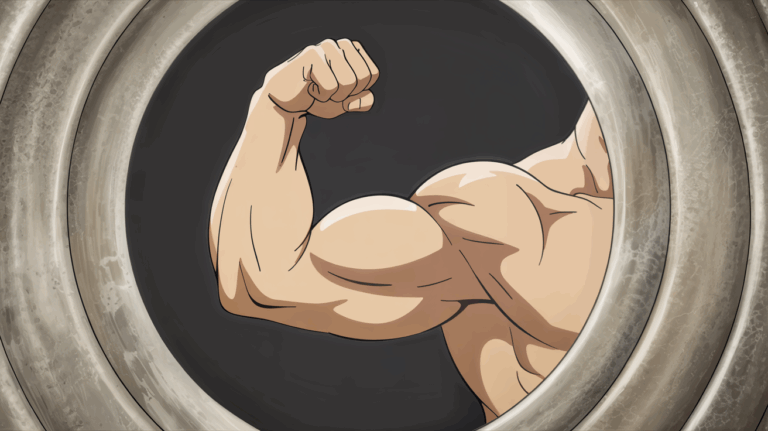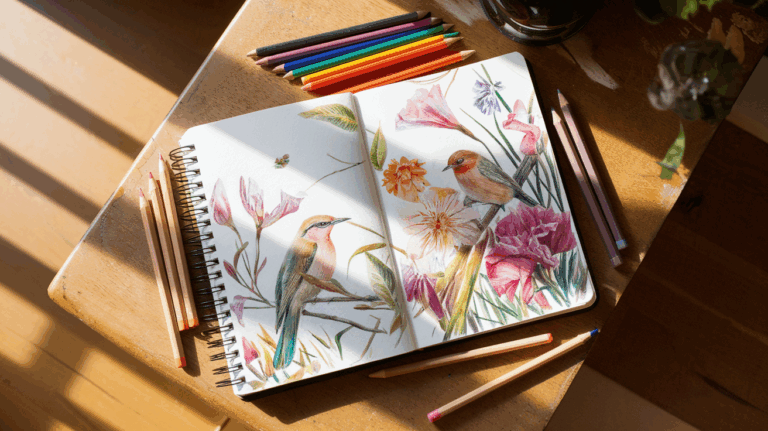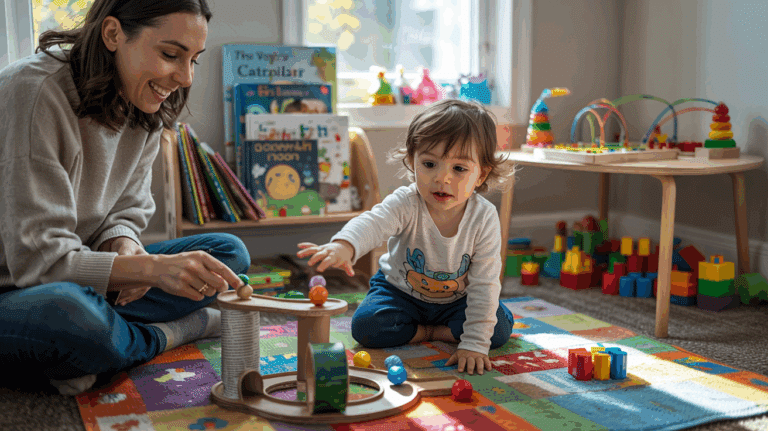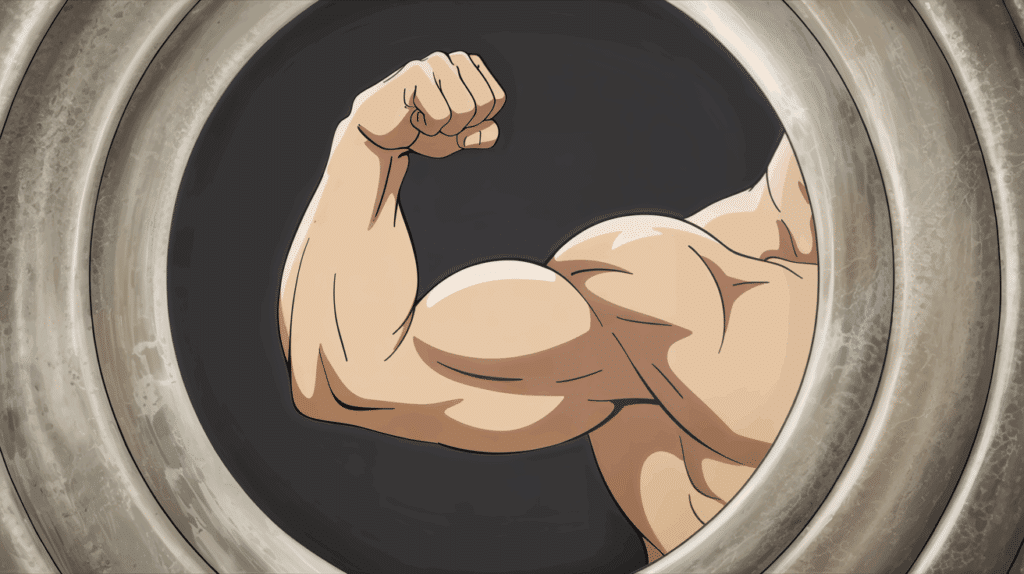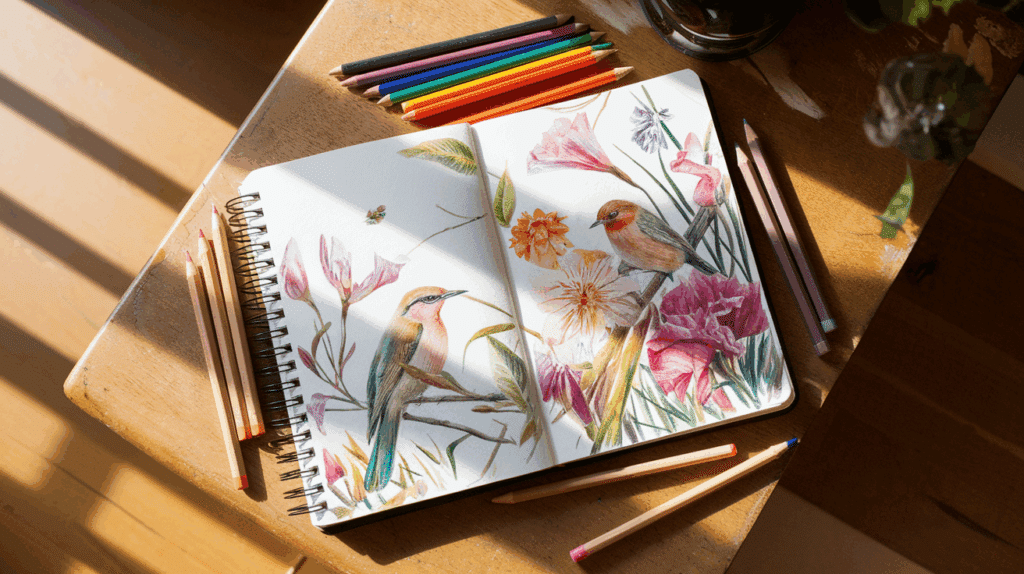Artists often struggle with keeping their work area neat. Brushes, paints, and papers scattered everywhere can limit your creative flow.
But what if you could find a simple way to organize all your art supplies?
Many artists are unaware that smart storage can actually enhance their productivity and help them complete more projects.
Proper storage does more than clean up your space; it also protects your expensive supplies and extends their lifespan. When you can find what you need quickly, you’ll spend more time creating and less time searching.
This article provides practical storage ideas that suit any budget and space. Read on to change your messy art corner into a well-organized studio that inspires you to create more.
Assessing Your Art Space
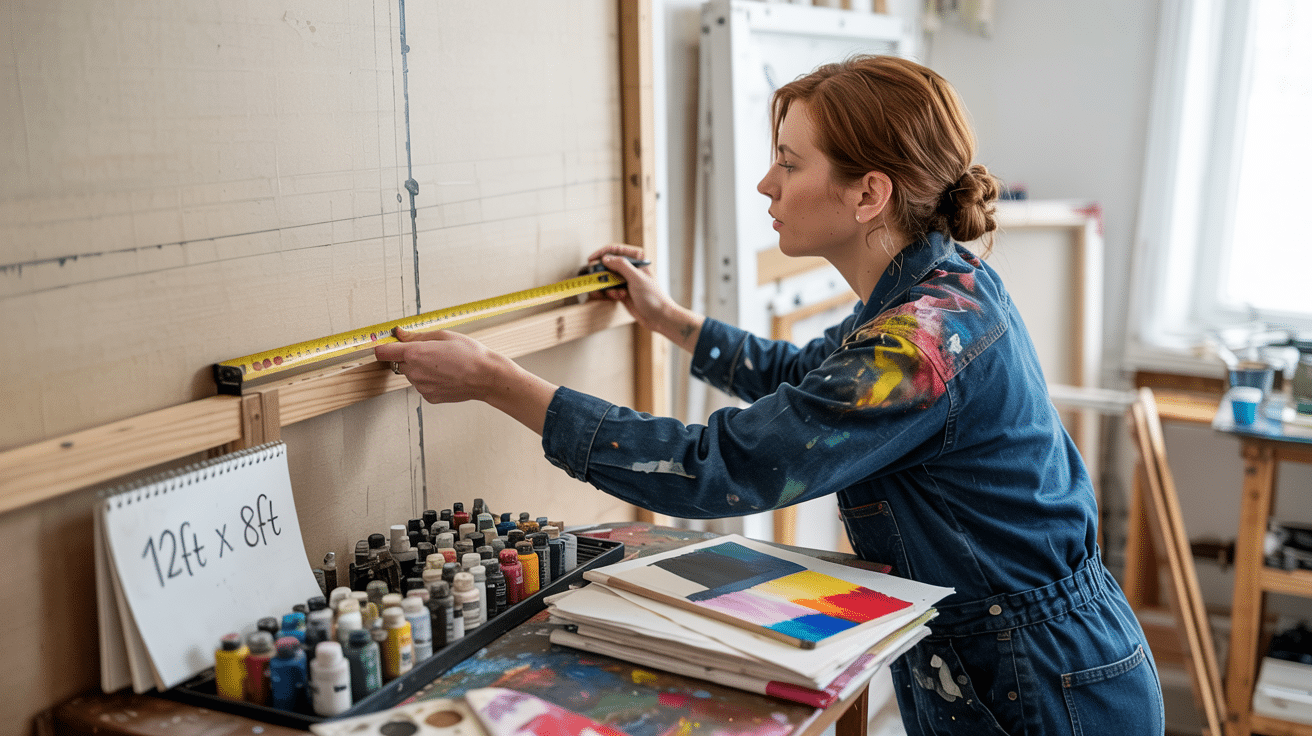
Before buying storage items, take time to look at your current art area. How much room do you have? What kinds of art do you make most often? Which tools do you use daily?
Start by taking everything out.
Sort items by type and frequency of use. Throw away dried paints, broken tools, and items you haven’t used in years.
Measure your walls, floor, and desk space. Note sunny spots where light might harm certain supplies. Check which areas you can reach easily and which might need step stools.
Think about your work style, too. Do you need all items visible at once? Or do you prefer a clean space with most things hidden away? Some artists work better with open shelving while others need closed cabinets to reduce visual noise.
Your space has specific needs based on its size, light, and your habits.
Why Proper Art Supply Storage Matters
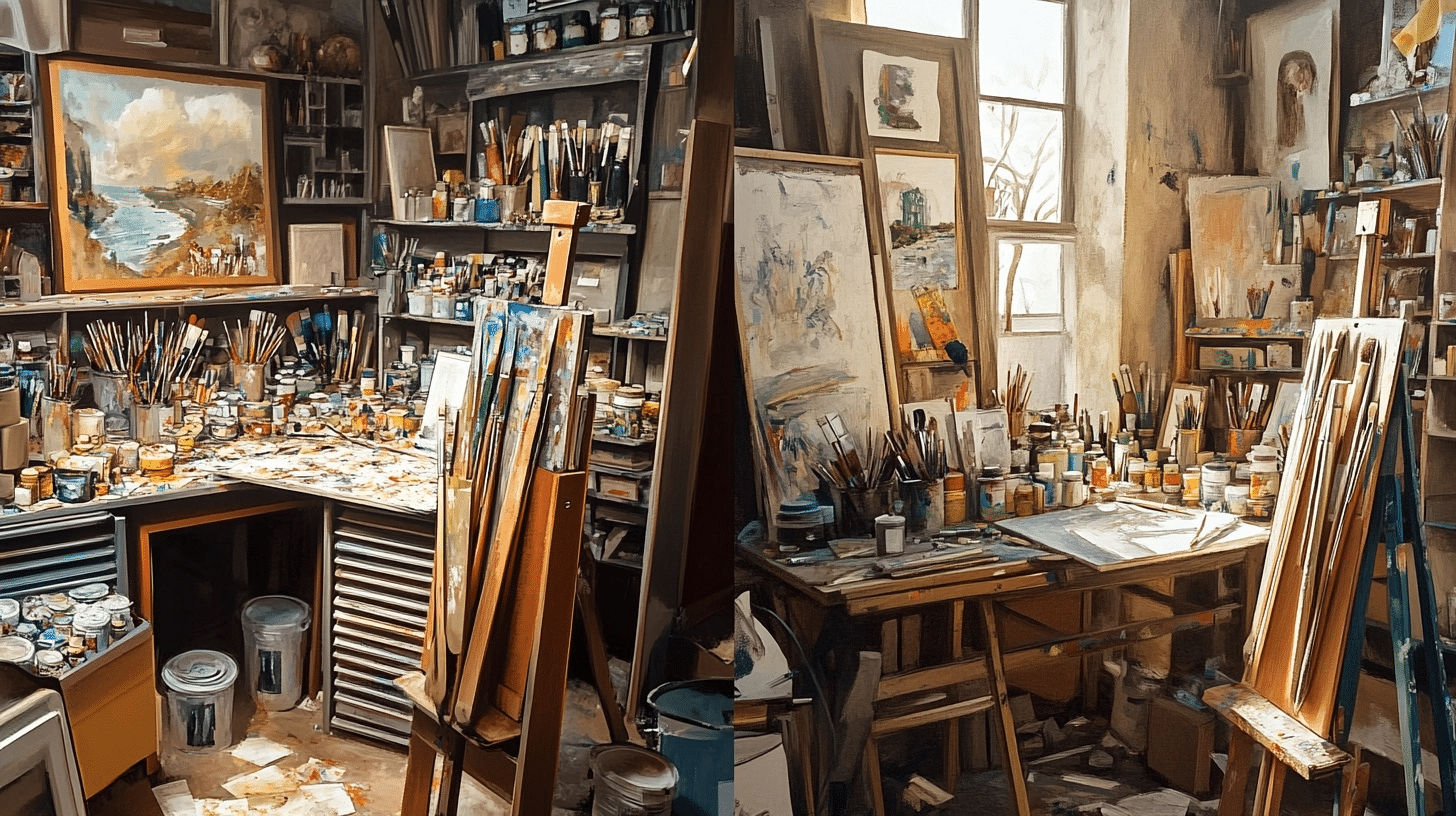
Good storage helps artists in ways many don’t think about. When you store your supplies properly, you save money and time while creating better art.
Poor storage leads to:
- Dried-out markers and paints
- Bent brushes and broken pencils
- Lost small items like erasers and clips
- Wasted time hunting for the right tool
When you start using proper art supply storage ideas, art sessions become more fun. Less time is spent looking for things, and more time is spent making art. Supplies also last much longer.
Good storage also keeps your work safe. Papers stay flat, not curled. Paints don’t dry out. Brushes hold their shape longer when stored right.
Effective art supply storage ideas offer:
- Better focus during art sessions
- Less money spent on replacing items
- Cleaner work with fewer smudges
- More space to actually create art
Your creative mind works best when it’s not stressed by mess and lost tools. Testing different art supply storage ideas can change how you feel about your creative space.
Clever Art Supply Storage Ideas
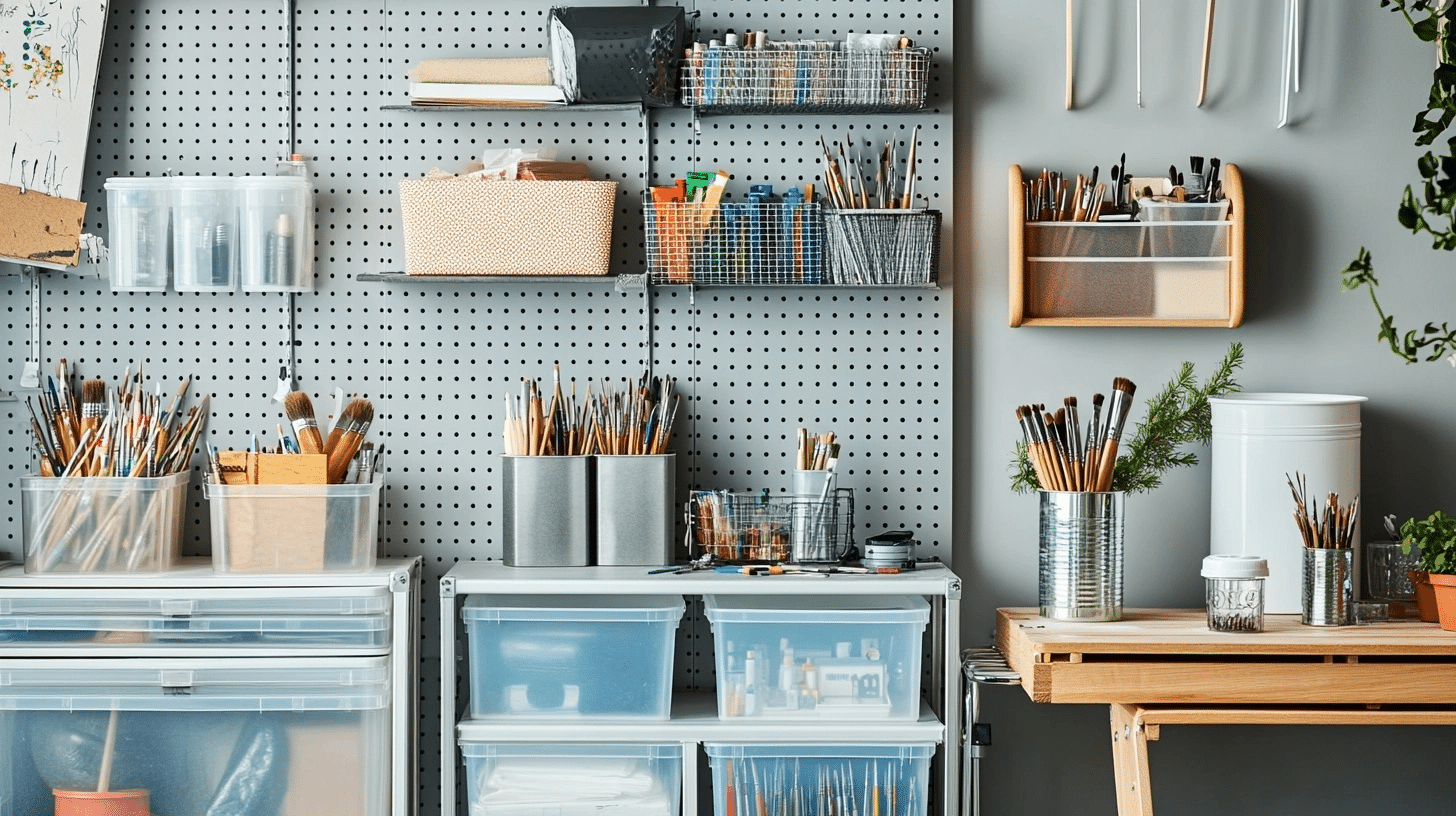
Finding the right storage for art supplies can make your creative time more fun. The perfect system keeps tools ready when you need them. Here are some tested ideas that work for artists of all kinds.
1. Plastic bins with labels
Clear plastic bins let you see what’s inside while keeping dust away. Add stick-on labels with words or pictures to find items faster. These work well for items you don’t use every day.
Materials required:
- Clear plastic bins with lids
- Label maker or adhesive labels
- Marker for writing
Purpose: Keeps similar items together and protects from dust and light damage.
2. Hanging metal containers
Metal cups or cans hung on a wall or rail save desk space. They work well for often-used tools like pens and brushes. The metal helps tools stay upright without tipping.
Materials required:
- Metal cups or containers
- Wall rail system or hooks
- Screws for mounting
Purpose: Frees up desk space while keeping tools within arm’s reach.
3. Floating shelves
Wall shelves hold supply bins, books, and finished art. You can install them at any height to use wall space that might go to waste. Paint them to match your room’s style.
Materials required:
- Wooden or metal shelves
- Wall brackets and screws
- Level tool for installation
Purpose: Uses vertical space and displays both supplies and finished artwork.
4. Pegboard wall
A pegboard holds hooks, bins, and shelves that you can move as your needs change. Paint it a fun color to make it part of your room design. This system grows with your supply collection.
Materials required:
- Pegboard sheet
- Assorted pegboard hooks and accessories
- Frame for mounting
Purpose: Creates a flexible system that can be changed based on your current projects.
5. Organized drawers with dividers
Large drawers can become a mess without dividers. Adding sections keeps small items from mixing together. This works well for beads, buttons, and other tiny pieces.
Materials required:
- Drawer dividers (wood, plastic, or cardboard)
- Measuring tape
- Non-slip drawer liner
Purpose: Prevents small items from mixing while maximizing drawer space.
6. Drawer dividers (wood or plastic)
Store-bought or DIY dividers turn any drawer into a sorted space. Cut them to fit your drawer size exactly. They help sort items by size, color, or type.
Materials required:
- Wood, plastic, or sturdy cardboard
- Saw or scissors
- Measuring tape and pencil
Purpose: Creates custom sections in drawers for better organization of smaller items.
7. Metal cans for brushes
Plain metal cans become pretty brush holders with paint or paper wraps. The weight keeps them from tipping when full of tools. Group brushes by size or type in different cans.
Materials required:
- Clean metal cans
- Decorative paper or paint
- Glue or tape
Purpose: Keeps brushes upright to protect bristles and maintain brush shapes.
8. Decorative trays
Nice-looking trays corral loose items on your desk. They look good while keeping small tools from rolling away. Change trays by season to refresh your work space.
Materials required:
- Trays in various sizes
- Non-slip liner (optional)
- Small containers for dividing space
Purpose: Contains items that would otherwise roll or slide off work surfaces.
9. Magnetic knife bar for palette knives
Kitchen knife strips hold metal art tools securely. Mount them at eye level for quick access. This keeps sharp or pointy tools safe and visible.
Materials required:
- Magnetic knife holder strip
- Wall mounting hardware
- Level for installation
Purpose: Safely stores metal tools while keeping them visible and easy to grab.
10. Clear plastic organizers
See-through boxes let you spot what you need right away. Stack them to use vertical space. These work well for items you need to see but not touch often.
Materials required:
- Clear plastic storage boxes
- Labels (optional)
- Shelf or cabinet space
Purpose: Allows visual inventory of supplies while protecting them from dust.
11. Art easel with built-in storage shelf
Easels with storage hold your current project supplies. Everything stays right where you need it. This creates a complete workstation in one piece of furniture.
Materials required:
- Art easel with shelf or tray
- Small containers for the shelf
- Clips for holding paper or canvas
Purpose: Combines work surface and storage in one space-saving unit.
12. Identical plastic containers with labels
Matching containers create a neat, uniform look. Clear sides let you check contents at a glance. This system makes your studio look tidy and well-planned.
Materials required:
- Matching storage containers
- Clear label holders
- Index cards for labels
Purpose: Creates visual calm through matching containers while organizing by type.
13. Glass jars with lids
Glass jars show off pretty supplies like colored pencils or beads. Lids keep dust out when items aren’t in use. The clear sides make finding the right color easy.
Materials required:
- Glass jars in various sizes
- Tight-fitting lids
- Labels (optional)
Purpose: Displays colorful supplies while protecting them from air and moisture.
14. Tiered rolling cart
Wheeled carts move where you need them, then roll away when done. Each shelf can hold different project supplies. This works well for artists who work in various spots.
Materials required:
- 3-tier rolling utility cart
- Small containers for sorting
- Labels for each level
Purpose: Creates mobile storage that can follow you to different work areas.
15. Group paints by color and size
Sorting paints by color makes finding the right one quick. Add size grouping for even faster selection. This system speeds up your work when mixing colors.
Materials required:
- Shelf, box, or drawer space
- Dividers or small containers
- Color-coded labels or tape
Purpose: Speeds up color selection and helps track which paints need replacing.
16. Plastic pantry risers for paint bottles
Step-style organizers let you see all paint bottles at once. Back row items stay visible and easy to grab. This turns a large shelf into a more useful display.
Materials required:
- Plastic tiered shelf organizers
- Non-slip liner
- Measuring tape for fit
Purpose: Improves visibility of items stored at the back of shelves or cabinets.
17. Mason jars for pencils and brushes
Clear glass jars with wide openings hold many brushes or pens. The heavy base stops tipping even when full. They add a rustic look to any art space.
Materials required:
- Mason jars in various sizes
- Colored sand or glass beads (optional for support)
- Labels or ribbon for decoration
Purpose: Provides stable, upright storage for tools while adding visual appeal.
18. Woven baskets for sketchbooks and palettes
Soft baskets protect book edges and hold odd-shaped items. They add warmth to a room full of hard surfaces. Choose ones with handles for easy moving.
Materials required:
- Woven baskets in various sizes
- Basket liners (optional)
- Tags for content labels
Purpose: Softens the look of storage while containing awkwardly sized items.
19. Built-in bookshelves
Room shelves hold art books and supply bins together. Paint them to match your walls for a clean look. Adjust shelf heights to fit your exact needs.
Materials required:
- Wood shelving
- Wall brackets or built-in supports
- Paint or finish that matches room
Purpose: Creates permanent, stable storage that can hold heavy items and equipment.
20. Flower pots for brushes
Clay pots add natural texture to your work area. The narrow bottom keeps brushes upright and grouped. Choose shapes and sizes that fit your desk style.
Materials required:
- Terracotta or ceramic pots
- Pebbles or glass beads for filler
- Saucers to protect surfaces
Purpose: Keeps tools upright while adding natural elements to your workspace.
21. Drawer system under slanted ceiling
Low cabinets work well in attic studios with sloped walls. Drawers pull out for full access to all items. This uses space that might otherwise go unused.
Materials required:
- Low drawer cabinets
- Drawer pulls that won’t catch on clothes
- Drawer liners for protection
Purpose: Maximizes awkward spaces while providing full-extension access to supplies.
22. Plastic pill boxes for small items
Weekly pill organizers hold tiny beads, gems, or findings. The small lids keep pieces from mixing. They stack to save space when not in use.
Materials required:
- Plastic pill organizers with dividers
- Labels for contents
- Small storage box to hold them
Purpose: Separates tiny items that would otherwise get lost or mixed together.
23. Organize supplies by rainbow color order
Color sorting makes finding and returning items simple. It also creates a pretty display when items are out. This system works well for kids’ art spaces.
Materials required:
- Clear containers or open shelving
- Color-coded labels or dividers
- Items sorted by color family
Purpose: Creates visual organization system that’s easy to maintain and pleasing to see.
24. Combination of open and hidden storage
Mix display shelves with closed cabinets for balance. Show off pretty supplies and hide messy ones. This creates a more finished, designed look.
Materials required:
- Open shelving units
- Cabinet or drawer storage
- Decorative containers for open shelves
Purpose: Balances the practical need to hide clutter with the visual appeal of displayed items.
25. Roll-up fabric paintbrush organizer
Fabric holders with slots keep brushes safe during travel. They roll up to save space when not in use. The fabric protects soft bristles from damage.
Materials required:
- Canvas or sturdy fabric
- Sewing machine or fabric glue
- Ribbon or string tie closure
Purpose: Protects brushes during transport and saves space when stored.
26. Sort markers, pencils, crayons by color
Color grouping helps find the exact shade you need. Store similar colors together in cups or bins. This speeds up selection during creative time.
Materials required:
- Cups, containers or dividers
- Color-coded labels
- Sorting system (by hue or color family)
Purpose: Speeds up tool selection and makes returning items to their proper place easier.
27. Rattan baskets for crayons or pastels
Natural baskets add texture and warmth to storage. They hold odd-shaped items that won’t stand up in cups. The soft sides protect fragile pastels.
Materials required:
- Shallow rattan or woven baskets
- Basket liners if items are dusty
- Labels for content identification
Purpose: Provides gentle storage for fragile items while adding natural texture.
28. Hanging plastic organizers on rods
Door or wall hangers with clear pockets show many items at once. They use vertical space that might go unused. Each pocket can hold different supply types.
Materials required:
- Over-door or wall-mounted pocket organizers
- Hanging rod or hooks
- Labels for each pocket
Purpose: Maximizes vertical wall space while keeping small items visible and accessible.
29. Utensil crock for large brushes
Heavy kitchen containers hold big brushes without tipping. The wide opening fits many sizes at once. These look great sitting out on your work table.
Materials required:
- Ceramic or stoneware utensil holder
- Non-slip mat for base (optional)
- Divider insert (optional)
Purpose: Provides stable, attractive storage for frequently used larger tools.
30. Ceramic dish for pastels or crayons
Shallow dishes hold flat items like pastels within reach. The raised edges keep them from rolling off. Choose light colors inside to see true colors of your supplies.
Materials required:
- Shallow ceramic dish or plate
- Felt bottom to protect surfaces
- Dividers (optional)
Purpose: Keeps small items contained while working and displays them attractively.
31. Cube shelf with drawers and open cubes
Mix-and-match cube systems combine open and closed storage. Place bins in some cubes and leave others open. This creates a custom look that fits your exact needs.
Materials required:
- Modular cube shelf unit
- Fabric or plastic storage cubes
- Drawer inserts for cubes
Purpose: Creates flexible storage that can be reconfigured as your supply collection changes.
32. Wicker storage baskets in cube shelves
Natural baskets warm up basic shelf units. They hide messy items but stay easy to pull out. Choose baskets with handles for quick access.
Materials required:
- Cube shelf unit
- Wicker baskets sized to fit cubes
- Labels for basket contents
Purpose: Adds texture and warmth while hiding visual clutter in an accessible way.
33. Special art supplies organizer case or bag
Ready-made cases hold many small items in one spot. They zip closed to keep dust out when not in use. These work well for travel or limited space.
Materials required:
- Art supply case with dividers
- Labels for sections
- Small containers for tiny items
Purpose: Keeps related supplies together in one portable, protected unit.
34. Bar cart on wheels for mobile storage
Drink carts hold art supplies with style. The wheels move it where you need it. Metal carts wipe clean from paint spills easily.
Materials required:
- Rolling bar or serving cart
- Containers for different supplies
- Non-slip liner for shelves
Purpose: Creates a mobile workstation that can be moved to different locations.
35. Large table or island with trays and jars
Central work tables with built-in storage keep all tools near. The flat top gives plenty of work space. Pull-out drawers hide less-used items.
Materials required:
- Work table with storage
- Surface protector mat
- Containers for sorting
Purpose: Combines work surface and storage in one central location.
36. Portable art caddy for toddlers
Kid-sized carriers have handles young hands can grip. The sections keep colors sorted but simple. Look for washable plastic that stands up to spills.
Materials required:
- Plastic caddy with handle
- Rounded edges for safety
- Washable surface
Purpose: Helps young children learn to organize while keeping supplies portable.
37. Repurposed spice racks for small supplies
Tiered spice shelves hold small paint bottles in view. The narrow shelves fit in tight spaces. Wall mounting frees up desk space.
Materials required:
- Spice rack (wood or metal)
- Wall mounting hardware
- Small containers that fit the shelves
Purpose: Uses otherwise wasted wall space for small item storage.
38. Hanging shoe organizer for markers and scissors
Door pocket panels hold many slim items. Clear pockets show what’s inside each one. This uses door space that would go unused.
Materials required:
- Over-door shoe organizer (clear preferred)
- Strong door hooks
- Labels for pockets
Purpose: Utilizes empty door space for extensive small item storage.
39. Magnetic strips for metal tools
Strong magnets hold scissors and metal rulers. Mount them at eye level for quick access. This keeps sharp tools safe and easy to grab.
Materials required:
- Magnetic tool holder strip
- Wall mounting screws
- Level for installation
Purpose: Safely stores sharp or metal tools while keeping them visible.
40. Clear jars with lids for beads and small items
See-through containers show what’s inside without opening. Screw-top lids keep tiny pieces from spilling. Group similar items in matching jars.
Materials required:
- Glass or plastic jars with secure lids
- Labels for contents
- Shelf or drawer space
Purpose: Provides spill-proof storage while allowing visual inventory of contents.
41. Stacking trays for paper and notebooks
Letter trays hold different paper sizes neatly. They stack to use vertical space. The open sides make grabbing what you need simple.
Materials required:
- Stacking paper trays
- Labels for contents
- Level surface for stability
Purpose: Separates flat items by size or type while maximizing vertical space.
42. Pegboard with hooks and small containers
Tool boards hold many items in view at once. The holes let you place hooks and bins where you need them. Move things around as your needs change.
Materials required:
- Pegboard sheet
- Assorted hooks and containers
- Frame or spacers for mounting
Purpose: Creates fully customizable wall storage that can change with your needs.
43. Rolling drawer carts
Wheeled storage moves to your work area then rolls away. The drawers pull out for full access to contents. Look for see-through drawers to spot items quickly.
Materials required:
- Multi-drawer rolling cart
- Drawer dividers or small containers
- Labels for drawer contents
Purpose: Provides mobile storage that can be tucked away when not in use.
44. Wall-mounted baskets or bins
Hanging bins free up floor and desk space. They work well for items you use often. Mount them at a height that’s easy to reach.
Materials required:
- Wall-mounted basket system
- Wall anchors and screws
- Labels for contents
Purpose: Uses wall space to store bulkier items that need to be accessed frequently.
45. Plastic drawer units with clear fronts
See-through drawers show what’s inside without opening. They stack to fit your space needs. Use small ones on desktops and larger ones on the floor.
Materials required:
- Plastic drawer units
- Drawer dividers or containers
- Labels (optional with clear fronts)
Purpose: Provides visible storage while protecting contents from dust.
46. Tiered desk organizers
Step-style desktop holders keep small items in reach. The different levels let you see everything at once. These work well for items you use every day.
Materials required:
- Desktop tiered organizer
- Non-slip base
- Small containers for tiny items
Purpose: Keeps frequently used small items visible and within reach on work surface.
47. Hanging baskets for yarn and ribbons
Wall or door baskets hold bulky items like yarn balls. The open entwine lets you see colors inside. This frees up drawer space for smaller items.
Materials required:
- Wire or woven hanging baskets
- Wall hooks or over-door hangers
- Labels for content types
Purpose: Stores bulky items that need air circulation in an accessible manner.
48. Repurposed utensil holders for brushes
Kitchen tool sorters make great brush holders. The sections keep brush types apart. The flat bottom stays steady on your desk.
Materials required:
- Utensil caddy or holder
- Dividers (if not built in)
- Non-slip bottom pad
Purpose: Keeps tools sorted by type while providing stable desktop storage.
49. Label everything with picture labels for kids
Photo labels help young artists find and return items. Use real pictures of the exact items inside. This builds good habits from an early age.
Materials required:
- Camera or images of supplies
- Printable labels or tape
- Clear tape for protection
Purpose: Helps children learn organization skills through visual matching.
50. Use muffin tins for sorting beads and small items
Baking pans hold tiny pieces during projects. The cups keep different items from mixing. Metal tins won’t tip over like plastic containers might.
Materials required:
- Metal muffin tin
- Small cups for sub-dividing
- Cover sheet for storage
Purpose: Creates temporary sorting system for active projects with small pieces.
51. Hanging file folders for paper and projects
File boxes store flat items by size or project. The tabs make finding specific items easy. These stack well on shelves when not in use.
Materials required:
- Hanging file box or crate
- File folders with tabs
- Labels for folders
Purpose: Organizes flat items in a way that prevents bending and allows easy access.
52. Use vintage suitcases for portable storage
Old cases add charm while holding odd-shaped items. They close to hide contents when not in use. The handles make moving them simple.
Materials required:
- Vintage suitcase or trunk
- Lining paper to protect inside
- Small containers for sorting
Purpose: Adds decorative storage that can be closed to hide contents.
53. Magnetic containers on fridge or metal boards
Tins with magnets stick to any metal surface. Use them on fridge sides or metal boards. They hold small items that might get lost in drawers.
Materials required:
- Small tins with clear lids
- Strong magnets
- Glue for attaching magnets
- Metal surface for mounting
Purpose: Creates easily accessible storage on otherwise unused surfaces.
54. Use clipboards on walls to hold papers and inspiration
Mounted clipboards display current projects and ideas. They keep papers flat and visible. Switch out the contents to match your current work.
Materials required:
- Clipboards (wood or plastic)
- Wall mounting hardware
- Binder clips for thicker stacks
Purpose: Displays works in progress or inspiration while keeping flat items from curling.
55. Repurpose old jars and containers with painted lids for a uniform look
Mismatched jars become a matched set with painted lids. The same color tops create a cohesive look. This reuses items you might already have.
Materials required:
- Assorted glass jars with lids
- Spray or brush-on paint
- Painter’s tape for clean edges
- Clear sealer for durability
Purpose: Creates budget-friendly matching storage while repurposing household items.
Maintaining Your Art Supply Organization Long-Term
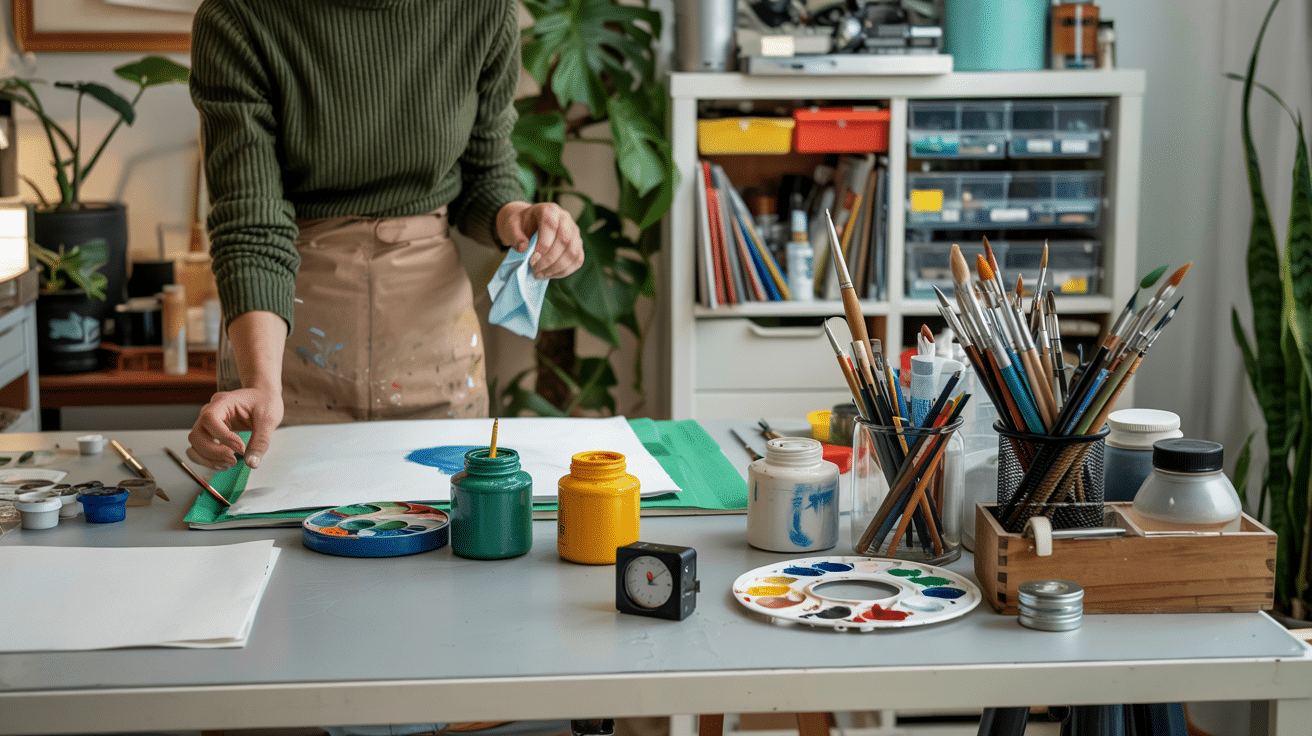
Keeping your art space tidy isn’t just about the first setup. The real trick is making your system last. Good habits make the difference between lasting order and quick chaos. Effective art supply storage ideas only work when paired with consistent maintenance.
- Set a 10-minute cleanup time after each art session.
- Put items back right after using them.
- Do a full review of your system every three months.
- Adjust containers as your supply needs change.
- Remove items you no longer use twice a year.
- Clean containers and shelves monthly to prevent dust buildup.
- Take photos of your setup to help remember where things go.
- Limit new purchases until you use what you have.
Start small with one area that bothers you most. Your future creative self will thank you when inspiration strikes.
Wrapping It Up
Now you have plenty of art supply storage ideas to transform your creative space. The right system makes finding tools easier and keeps your supplies in good condition longer.
Remember these key points about effective storage: choose solutions that fit your space and work style, label containers clearly, group similar supplies together, and set aside regular time for maintenance.
The best storage system is one you’ll actually use consistently. Start small with one area that bothers you most. Once that’s working well, move to the next space.
Ready to organize your art supplies? Pick one idea from this list and try it this weekend.
Your future creative self will thank you when inspiration strikes and everything is right where you need it.






